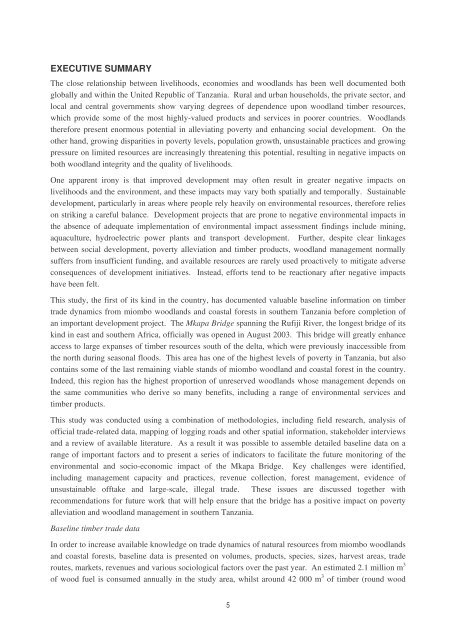Bridging the Gap: linking timber trade with infrastructural ...
Bridging the Gap: linking timber trade with infrastructural ...
Bridging the Gap: linking timber trade with infrastructural ...
Create successful ePaper yourself
Turn your PDF publications into a flip-book with our unique Google optimized e-Paper software.
EXECUTIVE SUMMARY<br />
The close relationship between livelihoods, economies and woodlands has been well documented both<br />
globally and <strong>with</strong>in <strong>the</strong> United Republic of Tanzania. Rural and urban households, <strong>the</strong> private sector, and<br />
local and central governments show varying degrees of dependence upon woodland <strong>timber</strong> resources,<br />
which provide some of <strong>the</strong> most highly-valued products and services in poorer countries. Woodlands<br />
<strong>the</strong>refore present enormous potential in alleviating poverty and enhancing social development. On <strong>the</strong><br />
o<strong>the</strong>r hand, growing disparities in poverty levels, population growth, unsustainable practices and growing<br />
pressure on limited resources are increasingly threatening this potential, resulting in negative impacts on<br />
both woodland integrity and <strong>the</strong> quality of livelihoods.<br />
One apparent irony is that improved development may often result in greater negative impacts on<br />
livelihoods and <strong>the</strong> environment, and <strong>the</strong>se impacts may vary both spatially and temporally. Sustainable<br />
development, particularly in areas where people rely heavily on environmental resources, <strong>the</strong>refore relies<br />
on striking a careful balance. Development projects that are prone to negative environmental impacts in<br />
<strong>the</strong> absence of adequate implementation of environmental impact assessment findings include mining,<br />
aquaculture, hydroelectric power plants and transport development. Fur<strong>the</strong>r, despite clear linkages<br />
between social development, poverty alleviation and <strong>timber</strong> products, woodland management normally<br />
suffers from insufficient funding, and available resources are rarely used proactively to mitigate adverse<br />
consequences of development initiatives. Instead, efforts tend to be reactionary after negative impacts<br />
have been felt.<br />
This study, <strong>the</strong> first of its kind in <strong>the</strong> country, has documented valuable baseline information on <strong>timber</strong><br />
<strong>trade</strong> dynamics from miombo woodlands and coastal forests in sou<strong>the</strong>rn Tanzania before completion of<br />
an important development project. The Mkapa Bridge spanning <strong>the</strong> Rufiji River, <strong>the</strong> longest bridge of its<br />
kind in east and sou<strong>the</strong>rn Africa, officially was opened in August 2003. This bridge will greatly enhance<br />
access to large expanses of <strong>timber</strong> resources south of <strong>the</strong> delta, which were previously inaccessible from<br />
<strong>the</strong> north during seasonal floods. This area has one of <strong>the</strong> highest levels of poverty in Tanzania, but also<br />
contains some of <strong>the</strong> last remaining viable stands of miombo woodland and coastal forest in <strong>the</strong> country.<br />
Indeed, this region has <strong>the</strong> highest proportion of unreserved woodlands whose management depends on<br />
<strong>the</strong> same communities who derive so many benefits, including a range of environmental services and<br />
<strong>timber</strong> products.<br />
This study was conducted using a combination of methodologies, including field research, analysis of<br />
official <strong>trade</strong>-related data, mapping of logging roads and o<strong>the</strong>r spatial information, stakeholder interviews<br />
and a review of available literature. As a result it was possible to assemble detailed baseline data on a<br />
range of important factors and to present a series of indicators to facilitate <strong>the</strong> future monitoring of <strong>the</strong><br />
environmental and socio-economic impact of <strong>the</strong> Mkapa Bridge. Key challenges were identified,<br />
including management capacity and practices, revenue collection, forest management, evidence of<br />
unsustainable offtake and large-scale, illegal <strong>trade</strong>. These issues are discussed toge<strong>the</strong>r <strong>with</strong><br />
recommendations for future work that will help ensure that <strong>the</strong> bridge has a positive impact on poverty<br />
alleviation and woodland management in sou<strong>the</strong>rn Tanzania.<br />
Baseline <strong>timber</strong> <strong>trade</strong> data<br />
In order to increase available knowledge on <strong>trade</strong> dynamics of natural resources from miombo woodlands<br />
and coastal forests, baseline data is presented on volumes, products, species, sizes, harvest areas, <strong>trade</strong><br />
routes, markets, revenues and various sociological factors over <strong>the</strong> past year. An estimated 2.1 million m 3<br />
of wood fuel is consumed annually in <strong>the</strong> study area, whilst around 42 000 m 3 of <strong>timber</strong> (round wood<br />
5
















